How to make more breast milk
When you start to breastfeed, you may wonder if you are feeding your baby correctly. If you notice that your baby is not gaining weight or you don’t have to change her diaper very often, she may not be getting enough breast milk. This can happen if the baby does not latch on properly or, somewhat less frequently, if you produce little milk. The good news is that most women make a third as much milk as their babies do, so there is a certain margin. If you are concerned, it is best to consult a healthcare professional. If you’re concerned about your milk supply levels, read on to find out ways to make more breast milk supply naturally and find out what may be the reason you’re producing less than you’d like.
Read Also: Breastfeeding: Frequently asked questions
Signs that the baby is getting enough breast milk

More important than trying to measure the amount of milk you produce is to watch for signs that your baby is getting enough milk. Think about these questions:
Does the baby gain weight?
One of the most reliable signs that breastfeeding is correct is the constant weight gain of the baby. Keep in mind that the baby will lose a little weight in its first days of life (it is usually not more than 7% of its birth weight, approximately), but it should be regained in a couple of weeks. Take a look at this growth chart, which will help you monitor your baby’s development along with visits to a healthcare professional.
Read Also: Healthy meals for your baby
Do you have to change your baby’s diapers frequently?
The number of newborn diapers your baby wears is a good indicator of whether he is getting enough milk. The normal thing is to change six wet diapers a day and check that your baby poops three or four times a day. The poop will be dark and sticky for the first few days, but then it will become mushy and yellowish. The urine should be light yellow, not yellow or dark orange.
How often does the baby suckle?
Newborns usually nurse 8 to 12 times a day, about every 2 to 3 hours. This demand can increase with sudden growth.
Does your baby seem happy between feedings?

If your baby seems satisfied, happy, alert, and active (and not angry or fussy) after nursing, chances are she is getting the food she needs.
If your baby is not drinking enough milk, you may also notice that he is sleepy all the time or most of the time. In this case, be sure to call a healthcare professional.
Read Also: Nutrition from 24 to 36 months: General recommendations
What aspects influence the production of breast milk?
If your newborn is not feeding properly, the most likely cause is that he is not latching on properly, and not that you are not producing enough milk. Find out how to get your baby to latch on properly and some additional tips. However, some factors can cause your breast milk production to decrease, such as the following:
- Waiting too long to start breastfeeding (ideally starting about an hour after delivery, however, in some cases this is not possible)
- Not breastfeeding often enough (experts recommend giving it 8 to 12 times a day)
- Taking certain medications, such as those containing pseudoephedrine or even certain types of hormonal contraceptives
- That your baby does not latch on properly to the nipple and, therefore, does not stimulate milk production
- Breast surgery
- That your baby is premature
- Gestational hypertension
- The obesity
- Insulin-dependent diabetes.
How to make more breast milk
The good news is that there are ways to increase your milk supply. These ideas can help:
Start breastfeeding as soon as possible to make more breast milk
If you can, try not to wait too long after delivery to start breastfeeding. Ideally, start around an hour later. However, in some cases (for example, if you are recovering from a C-section), you can start breastfeeding later. Don’t worry about that, because here are more tips to increase your milk supply.
Use a breast pump frequently to make more breast milk

The more milk you can express, the more you will produce. If you work, try to pump your milk for 15 minutes every few hours. You can also save some time by pumping both breasts at the same time with a double pump.
Breastfeed frequently to make more breast milk

Your baby will likely want to breastfeed 8 to 12 times a day. If you breastfeed frequently or use a breast pump between feedings, your breasts will be stimulated to produce more milk.
Make sure your baby latches on to the nipple properly
It is important that the baby latches on to the nipple correctly and swallows when nursing. If in doubt, a lactation consultant or healthcare professional can help you confirm that the baby latches on to the breast and swallows properly.
Give the baby both breasts
Remember to alternate between breasts. Both must be emptied to produce more milk. You can also use a breast pump to remove accumulated milk.
Don’t skip the shots
Follow the feeding schedule. If you work while breastfeeding and pumping, try not to skip any feedings, as it can affect your milk supply.
Consult a healthcare professional if you take medication
Some medications can reduce milk production. Consult a healthcare professional about possible medication options, as there may be solutions you can take while breastfeeding.
Ask a lactation consultant for help to make more breast milk
If you still don’t know if you are producing enough milk for your baby, talk to a lactation consultant or healthcare professional for one-on-one assistance.
Do not worry
Even if you think you are producing little breast milk, you can take steps to increase it. Follow these tips and talk to a healthcare professional to make sure your baby gets the food she needs.
